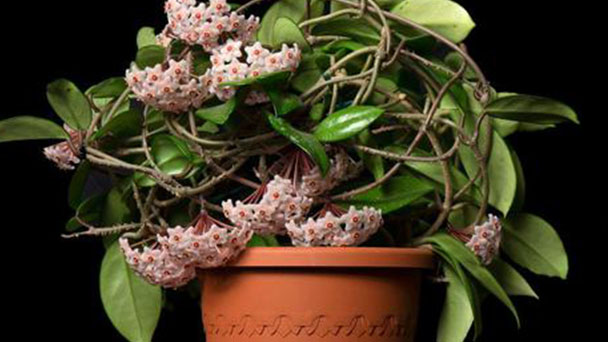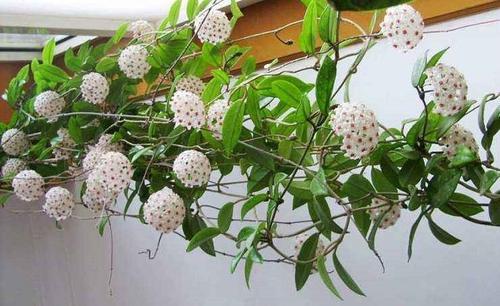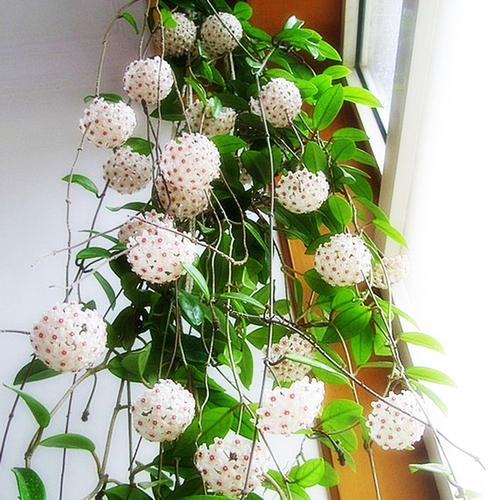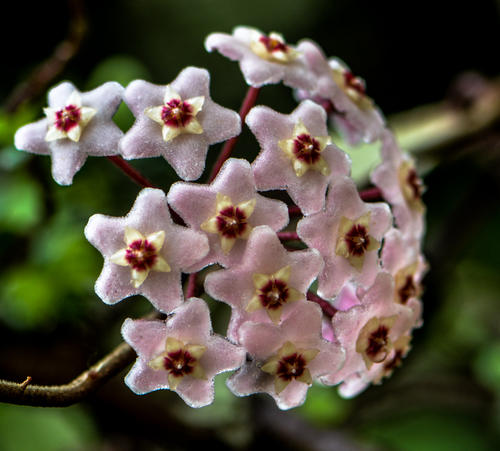Hoya plant profile
Written by Maggie
Mar 31 2021

Hoya flower, also known as wax plant, wax flower, Indian rope plant, porcelain flower, honey plant, is a perennial evergreen lianas belonging to the family Hoya. Stem is fleshy, as long as 7 meters, internode air roots, and climbing strength is strong. Opposite leaves, thick fleshy, whole edge veins are not obvious, similar to waxy, fat and moist, give a person to enrich the feeling of wealth.
Hoya picture

Hoya info
| Botanical Name | Hoya carnosa |
| Common Names | Hoya, wax plant, wax flower, Indian rope plant, porcelain flower, honey plant |
| Plant Type | Tropical succulent |
| Sun | Bright, natural light |
| Hardiness Zones | 8-11 (USDA) |
| Flower color | Yellow, orange, pink, burgundy, white, near black |
| Native Area | Tropical Asia, Australia |
| Mature size | 12-20 ft. |
Morphological characteristics of Hoya
Stems
A Hoya is a climbing shrub, attached to a tree or rock; The angry root on the stem node.
Leaf
Hoya leaves are opposite, fleshy, ovoid to ovoid oblong, 3.5 -- 12 cm long and 3 -- 4.5 cm wide, obtuse at tip, rounded at base;Lateral veins are not obvious, about 4 pairs.
Flowers
Hoya is cyme shape, axillary, with about 30 flowers; Flowers are white, 2 cm in diameter; Corolla is radiate, corolla tube short, lobes glabrous outside, inner surface poly papillate; Corolla is stellate, outer Angle acute, midridge raised, margin reflexed into 1 pore, inner Angle acute, erect; Pollen blocks 1 per chamber, elongated, side transparent.
Fruit
Fruit of Hoya is follicle-shaped, smooth, 7.5-10 cm long; Seed is apical with white silky stud hairs.
The ecological habits of Hoya
Hoya likes high temperature, humid semi-shade environments and slightly dry soil, so sun exposure must be avoided in summer and autumn. Although they can grow without direct sunlight, they need three to four hours of sunlight each day to bloom.
Hoya prefers fertile, breathable, well-drained soil, and requires plenty of moisture during growth, but avoid too much moisture.Gradually reduce watering after autumn.
How to grow and care for Hoya
Planting
4 parts of peat soil, 3 parts of wood chips and 3 parts of vermiculite can be mixed as the cultivation substrate for Hoya, and put into the dish of seedling holes. Take 15-20 cm cuttings from the mother Hoya and insert them into the matrix. In maintenance, attention should also be paid to the existing buds and flowering plants, not free to move the pot, otherwise it is easy to cause falling flowers and buds.
Fertilization
Fertilization is mainly organic fertilizer or compound fertilizer. Growth season 1-2 times a month with the combination of nitrogen and phosphorus thin cake fertilizer water. The rest of the time because the Hoya growth is slow, to stop fertilizing, so as not to waste fertilizer or cause fertilizer damage.
Watering
Hoya is a succulent plant, the leaves contain more water, the growing season watering should see dry wet. Overwatering makes rotten roots, but water them adequately in summer. Because Hoya likes wet, it should pay attention to the foliar water often, in order to increase the air humidity.
Temperature, illumination
Hoya family cultivation of spring and autumn season should be placed in the south window or near the indoor south window to see the light, that is, can keep the leaf color green and bright, blooming well. But summer has moved to shade, to prevent strong light, otherwise the leaf color is easy to turn yellow. If put for a long time in the light insufficient place, criterion leaf color becomes pale, the flower is little and not colourful.
Hoya is not cold resistant, and the suitable temperature for growth is 15-25℃. Even in winter, the room temperature should be kept above 10℃. If it is lower than 5℃, it is vulnerable to cold damage, causing falling leaves and even the death of the whole plant.
Overwintering
Hoyas will bloom throughout the summer months, and you should bring them indoors when temperatures drop below 50 degrees Fahrenheit.
Potted plants management
Light pot Hoya, spring and autumn season should be placed in the outdoor south window or near the indoor south window culture, and can keep the leaf color green and bright, flowering well. We need to move to the summer shade, to prevent strong light, otherwise the leaf color is easy to turn yellow. If you put Hoya for a long time in a light insufficient place, the criterion leaf color becomes pale, the flower is little and not colourful.
Fertilizer growth season in addition to watering to see dry see wet, but also often to the leaf spraying. Summer watering should be sufficient, at the same time, we should pay attention to increase air humidity, in order to grow healthily. Growth season 1 times a month -2 times of nitrogen and phosphorus combination of thin cake fertilizer water.
Suitable temperature Hoya is not cold resistant, and the suitable temperature for growth is 15℃-25℃. The room temperature in winter should be kept above 10℃. If the temperature is lower than 5℃, it is vulnerable to cold damage, causing falling leaves and even the death of the whole plant.
Change the pot should choose the high foot basin, the young Hoya is suitable to change the pot once a year in spring, and the plant can be changed once every 1 to 2 years. For the existing buds and flowers are open plants, not free to move the pot, otherwise easy to cause falling buds and flowers.
Pruning young Hoya should pick the heart early, promote branching, and promptly set up the scaffold, so that its upward growth. Cut off some of the old roots when repotting.A fter the flower is withered, let it fall naturally. You can't cut off the flower stem, because the flower buds in the second year will mostly germinate in the same place. If you cut them off, the number of flowers in the coming year will be affected.This is one of the main reasons why many flower lovers raise Hoya to flower with little or no flowers.
Hoya's propagation
Hoya can be propagated by cutting or layering, and root easily above 20 °C. In addition to the new tendrils of undeveloped leaves, can be used as cuttings.

Disease & pest control of Hoya
Hoya common anthrax, bad spot disease, leaf spot harm, can be used 50% carbendazim WP 600 times liquid or 70% mancozeb WP 400-6W times liquid spray prevention and control.In addition to scale insects and powder breakage hazards, 40% oxidized dimethoate emulsion 800-100 () times solution or 80% dichlorvos emulsion IOC can be used. Double liquid spray kill.
Scale insects
Scalar insects are often parasitic on leaf sheaths and stems of Hoya, especially in the dark places such as the back of leaf sheaths and so on. They use the piercing mouthparts to penetrate into the stomata of plants to absorb nutrients, which has a great impact on the growth of Hoya, resulting in gradual decline and yellowness of seedlings, and easy infection and death.High temperature and rainy summer, poor ventilation or lack of sunlight, easy to occur scale insect harm.
Prevention and control methods: pay attention to ventilation, as early as possible to find the insect body, a small amount of occurrence with a brush to brush the insect body, and then rinse with water. Chemical methods should be used to control insect pests when they occur in large areas. In the peak period of nymphs, spray 1 ~ 3 times. For example, use 80% dichlorvos emulsion or 3% pyrethrin 1000 times liquid every 7 ~ 10 days to spray 1 times, consecutive 3 times.
Aphids
Aphids are more species, is a small and soft common insects, often cluster in branches, leaves of the young stem slightly absorb nutrients, so that the plant growth stagnation, leaf yellow.Its secretions often lead to a variety of molds parasitic, especially easy to lead to the occurrence of coal dirty disease. When insect pests occur in small quantities, the leaves can be washed with water or soapy water, or the affected parts can be removed. Chemical control can be used deltamethrin 1000 ~ 1500 times of liquid or trichlorfon 1000 times of liquid spraying control, every 5 ~ 7 days once, continuous spraying three times, has a good control effect.
Mites pest
The main mite pests are red spider, yellow spider and pseudo arachnid, which occur most easily in dry and high temperature environment.Insects parasitic on the leaves, the sun often lives in the back of the leaf or leaf sheath activities, absorb the nutrients of new buds and leaves, so that the leaf color. The injured leaves of Hoya often appear a small gray dot, and then become silver gray or grayish brown rough irregular spots or patches, serious leaf back can be found screen leaves, gradually appear yellow indentation, soon atrophy deformation.
Prevention and control methods: spray the upper and lower sides of the leaf with soapy water, soapy water can attach to the leaf, form a film, prevent or reduce mite parasitism;Spray with chemical agents such as acetylene mite and pyridaben. When spraying, the upper and lower sides of the leaf and the base of the leaf should be sprayed, once a week for 3 consecutive times.
The species classification of Hoya
There are many different varieties of horticulture, such as white variegated leaf, red variegated leaf, curly leaf, needle leaf or long rhombus leaf, and so on.
Ring crown HoyaHoya anulata
Cultivation skills: cultivation is simple, water should not be too much, winter appropriate heat preservation, shading 65%.
The southern HoyaHoya australis
Cultivation skills: cultivation is simple, inexpensive and good for appreciating flowers and leaves, shading 65%.
Hoyahoya australis rubicola
Cultivation skills: simple cultivation, light and warm water without too much special requirements.
Southern Hoya(subspecies)Hoya australis sanae
Cultivation skills: simple cultivation, cold resistance, more afraid of high temperature and no ventilation.
Hoya Australis variegated out on the south side
Cultivation skills: simple cultivation, suitable for both drought and flood, hot and cold, no special requirements, beautiful flowers and leaves.
Thorn HoyaHoya acicularis
Cultivation skills: cultivation is simple, not high temperature resistance, moderate water, shading 55%- 65%
Hoyahoya Blashernaezii
Cultivation skills: simple cultivation, drought and flood harvest, not strong light, with 65% is more suitable.
Cumin HoyaHoya cummingiana
Cultivation skills: cultivation is easy, pay attention to ventilation and appropriate thin fertilizer, shading 65-70% is more appropriate.
The distribution of Hoya
Distribution
Hoya is produced in Yunnan, Guangxi, Guangdong, Fujian and Taiwan provinces.
Hoya is cultivated in gardens both at home and abroad.
Habitat
Hoya is found in plains or mountains, attached to trees or rocks.
Hoya uses
Medical use
Hoya can treat cough of lung heat, orchitis, otitis media, mastitis, swollen carbuncles, scrofula, swollen joints, poor milk, blockage of milk. Internal consumption: decoction, 6-15g, fresh, 30-90g, or mashed minced juice. External use: Fresh amount, ramming.
Garden use of Hoya
Hoya is often used as a hedge, stone and wall climbing material in areas where it can be cultivated on the open ground. Potted for hanging cultivation or a few for pot decoration.

Latest Updated
- Benefits of Bugleweed - 7 Science-backed Health Benefits
- Bugleweed Dangers & Side Effects - Is It Poisonous?
- How to Plant Evergreen Trees - What You Should Know
- When to Plant Evergreens - Grow Guide for Evergreen Trees
- 12 Wonderful Evergreen Shrubs for Your Garden
- 12 Popular Evergreen Plants with Pictures for Beginners
- When And How To Prune A Lilac Bush Like a Pro
- How to Grow & Care for Lilac Vine (Hardenbergia Violacea)
- Japanese Lilac Tree (Syringa Reticulata) Care & Propagation Guide
- Shumard Oak Pros and Cons - What to Know
Popular Articles
- Winter maintenance of Antirrhinum Majus
- How to Grow Terminalia Mantaly Tree
- How to Grow and Care for Crossostephium Chinense
- How to grow Antirrhinum Majus in spring
- Peristeria Elata (Dove Orchid) Profile: Info & Care Guide
- Underwatered Snake Plant (Sansevieria Trifasciata) - Signs And How To Fix
- How to Care for Brazilian Jasmine Plant (Mandevilla Sanderi)
- How to Grow & Care for Graptopetalum Purple Delight in Summer
- Rosa Chinensis (China Rose): Plant Growing & Care Tips
- How to Care for Baby Sun Rose (Aptenia Cordifolia)